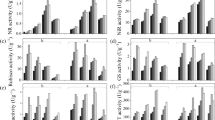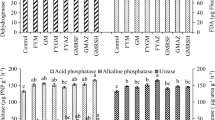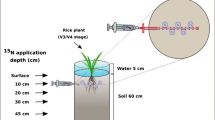Abstract
Adequate nitrogen availability to plants for growth is one of the most important reasons for fertilizer application. Though organic alternatives are recommended, there is uncertainty of their nutrient release characteristics, especially during critical growth stages of a crop. In a 10-year-long experiment on nutrient management for rice-wheat cropping, ion exchange resin (IER) membrane strips were used as plant root simulators to determine daily NH4 +-N and NO3 −-N availability in soil solution during the rice growing season. The management included inorganic fertilizers at 100% recommended rate (F), compared to reduced rate (55%) of inorganic fertilizers supplemented with organic inputs via green manuring with Sesbania (GM), biomass incorporation of an opportunity legume crop-green gram (Vigna radiata) (LE), 1/3rd wheat stubble retention and soil incorporation (WS), 1/3rd rice stubble retention and soil incorporation (RS), and farmyard manure application (FYM). The total amount of available N (NH4 + + NO3 −) recorded for the full season was in the order GM (221 μg cm−2) > F (184 μg cm−2) > RS (181 μg cm−2) > FYM (176 μg cm−2) > WS (176 μg cm−2) > LE (175 μg cm−2). Both grain and straw yield related directly and significantly to the N mineralization in soil at 30–60 days after transplanting (DAT), indicating that fertilizer N application before 30 DAT and after 60 DAT could mostly be a loss in transplanted rice crop. Green manured (GM) soils maintained steadily high N mineralization rates throughout the rice growing period. The best alternative to cut down inorganic fertilizer use in rice cropping would be the biomass incorporation from leguminous green manuring crops. Integration of organics afforded almost 50% reduction in recommended inorganic fertilizer use while maintaining better N mineralization status at the critical growth stages of rice.







Similar content being viewed by others
Data Availability
The data supporting the findings in the manuscript are available from the corresponding author on reasonable request.
References
Bhagat RM, Bhardwaj AK, Sharma PK (2003) Long term effect of residue management on soil physical properties, water use and yield of rice in north-western India. J Indian Soc Soil Sci 51:111–117
Bhardwaj AK, Jasrotia P, Hamilton SK, Robertson GP (2011) Ecological management of intensively cropped agro-ecosystems improves soil quality with sustained productivity. Agric Ecosyst Environ 140:419–429. https://doi.org/10.1016/j.agee.2011.01.005
Bhardwaj AK, Rajwar D, Mandal UK, Ahamad S, Kaphaliya B, Minhas PS, Prabhakar M, Banyal R, Singh R, Chaudhari SK, Sharma PC (2019) Impact of carbon inputs on soil carbon fractionation, sequestration and biological responses under major nutrient management practices for rice-wheat cropping systems. Sci Rep 9:9114. https://doi.org/10.1038/s41598-019-45534-z
Blanchet G, Gavazov K, Bragazza L, Sinaj S (2016) Responses of soil properties and crop yields to different inorganic and organic amendments in a Swiss conventional farming system. Agric Ecosyst Environ 230:116–126. https://doi.org/10.1016/j.agee.2016.05.032
Brown KW, Thomas JC, Duble RL (1982) Nitrogen source effect on nitrate and ammonium leaching and runoff losses from greens. Agron J 74:947–950. https://doi.org/10.2134/agronj1982.00021962007400060005x
Casida LE, Klein DA, Santoro T (1964) Soil dehydrogenase activity. Soil Sci 98:371–376
Cody RP, Smith JK (1997) Repeated measures designs. In: Applied statistics and the SAS programming language, 4th edn. Prentice Hall, Upper Saddle River, pp 181–220
Corbeels M, O’Connell AM, Grove TS, Mendham DS, Rance SJ (2003) Nitrogen release from eucalyptus leaves and legume residues as influenced by their biochemical quality and degree of contact with soil. Plant Soil 250:15–28. https://doi.org/10.1023/A:1022899212115
De Datta SK (1981) Mineral nutrition and fertilizer management of rice. In: Principles and practices of rice production. Wiley-Interscience, John Wiley & Sons, New York, pp 173–220
Dikgwatlhe SB, Kong FL, Chen ZD, Lal R, Zhang HL, Chen F (2014) Tillage and residue management effects on temporal changes in soil organic carbon and fractions of a silty loam soil in the North China Plain. Soil Use Manag 30:496–506. https://doi.org/10.1111/sum.12143
DOF (2010) Indian fertilizer scenario. Department of Fertilizers, Ministry of Chemicals and Fertilizers, Government of India. pp. 149. http://fert.nic.in/sites/default/files/Indian-Fertilizer-Scenario.pdf. Accessed 1 Feb 2019
Eivazi F, Tabatabai MF (1988) Glucosidases and galactosidases in soils. Soil Biol Biochem 20:601–606. https://doi.org/10.1016/0038-0717(88)90141-1
Ghosh BC, Bhatt R (1998) Environmental hazards of nitrogen loading in wetland rice fields, in: proceedings of the first international nitrogen conference, pp. 123-126. https://doi.org/10.1016/B978-0-08-043201-4.50022-8
Guo X, Chen L, Zheng R, Zhang K, Qiu Y, Yue Y (2019) Differences in soil nitrogen availability and transformation in relation to land use in the Napahai wetland, southwest China. J Soil Sci Plant Nutr 19:92–97. https://doi.org/10.1007/s42729-019-0013-0
Hao XH, Liu SL, Wu JS, Hu RG, Tong CL, Su YY (2008) Effect of long-term application of inorganic fertilizer and organic amendments on soil organic matter and microbial biomass in three subtropical paddy soils. Nutr Cycl Agroecosys 81:17–24. https://doi.org/10.1007/s10705-007-9145-z
Kandeler E, Gerber H (1988) Short-term assay of soil urease activity using colorimetric determination of ammonium. Biol Fert Soils 6:68–72. https://doi.org/10.1007/BF00257924
Ladoni M, Kravchenko AN, Robertson GP (2015) Topography mediates the influence of cover crops on soil nitrate levels in row crop agricultural systems. PLoS One 10:e0143358. https://doi.org/10.1371/journal.pone.0143358
Lal R (2005) World crop residues production and implications of its use as a biofuel. Environ Int 31:575–584. https://doi.org/10.1016/j.envint.2004.09.005
Liu MQ, Hu F, Chen XY, Huang QR, Jiao JG, Zhang B (2009) Organic amendments with reduced chemical fertilizer promote soil microbial development and nutrient availability in a subtropical paddy field: the influence of quantity, type and application time of organic amendments. Appl Soil Ecol 42:166–175. https://doi.org/10.1016/j.apsoil.2009.03.006
McSwiney CP, Snapp SS, Gentry LE (2010) Use of N immobilization to tighten the N cycle in conventional agroecosystems. Ecol Appl 20:648–662. https://doi.org/10.1890/09-0077.1
Mishra VK, Srivastava S, Bhardwaj AK, Sharma DK, Singh YP, Nayak AK (2015) Resource conservation strategies for rice-wheat cropping systems on partially reclaimed sodic soils of indo-Gangetic region and their effects on soil carbon. Nat Resour Forum 39:110–122
Nyiraneza J, Snapp S (2007) Integrated management of inorganic and organic nitrogen and efficiency in potato systems. Soil Sci Soc Am J 71:1508–1505. https://doi.org/10.2136/sssaj2006.0261
Palm O, Weerakoon WL, De Silva MAP, Rosswall T (1988) Nitrogen mineralization of Sesbania sesban used as green manure for lowland rice in Sri Lanka. Plant Soil 108:201–209. https://doi.org/10.1007/BF02375650
Phongpan S, Mosier AR (2003) Effect of rice straw management on nitrogen balance and residual effect of urea-N in an annual lowland rice cropping sequence. Biol Fertil Soils 37:102–107. https://doi.org/10.1007/s00374-002-0566-1
Qian P, Schoenau JJ (2005) Use of ion-exchange membrane to assess nitrogen-supply power of soils. J Plant Nutr 28:2193–2200. https://doi.org/10.1080/01904160500324717
Said-Pullicino D, Cucu MA, Sodano M, Birk JJ, Glaser B, Celi L (2014) Nitrogen immobilization in paddy soils as affected by redox conditions and rice straw incorporation. Geoderma 228-229:44–53. https://doi.org/10.1016/j.geoderma.2013.06.020
Schoenau JJ, Bolton K, Panchuk K (2000) Managing manure as a fertilizer. Farm facts. Saskatchewan Agriculture and Food (ISSN 0840-9447)
Schomberg HH, Steiner JL, Unger PW (1994) Decomposition and nitrogen dynamics of crop residues: residual quality and water effects. Soil Sci Soc Am J 58:372–381. https://doi.org/10.2136/sssaj1994.03615995005800020019x
Snapp SS, Mafongoya PL, Waddington S (1998) Organic matter technologies for integrated nutrient management in smallholder cropping systems of southern Africa. Agric Ecosyst Environ 71:85–200. https://doi.org/10.1016/S0167-8809(98)00140-6
Subbiah BV, Asija GL (1956) A rapid procedure for determination of available nitrogen in soils. Curr Sci 25:259–260
Xinqiang L, Junli Y, Miaomiao H, Hua L, Liang L, Guangming T (2014) Modeling the fate of fertilizer N in paddy rice systems receiving manure and urea. Geoderma 228-229:54–61. https://doi.org/10.1016/j.geoderma.2013.09.002
Yaduvanshi NPS, Sharma DR, Swarup A (2013) Impact of integrated nutrient management on soil properties and yield of rice and wheat in a long-term experiment on a reclaimed sodic soil. J Indian Soc Soil Sci 61:188–194
Zhang X, Wang H, Hui X, Wang Z, Liu J (2019) Effects of different fertilization and fallowing practices on soil carbon and nitrogen mineralization in a dryland soil with low organic matter. J Soil Sci Plant Nutr 19:108–116. https://doi.org/10.1007/s42729-019-0016-x
Zhu ZL, Cap GX, Simpson JR, Zhang SL, Chen DL, Jackson AV, Freney JR (1989) Processes of nitrogen loss from fertilizers applied to flooded rice fields on a calcareous soil in north-central China. Fert Res 18:101–115. https://doi.org/10.1007/BF01049507
Acknowledgments
The financial support for this work was provided by NICRA project (National Innovations in Climate Resilient Agriculture, DARE-ICAR-NICRA-03; CSSRI Project No. 1006538). The findings and opinions expressed herein are those of the authors and do not reflect the views of the funding agency.
Author information
Authors and Affiliations
Corresponding author
Ethics declarations
Conflict of Interest
The authors declare that they have no competing interests. The funding agency had no role in designing the study, data collection and analysis, and preparation of the manuscript.
Additional information
Publisher’s note
Springer Nature remains neutral with regard to jurisdictional claims in published maps and institutional affiliations.
Rights and permissions
About this article
Cite this article
Bhardwaj, A.K., Rajwar, D., Basak, N. et al. Nitrogen Mineralization and Availability at Critical Stages of Rice (Oryza sativa) Crop, and Its Relation to Soil Biological Activity and Crop Productivity Under Major Nutrient Management Systems. J Soil Sci Plant Nutr 20, 1238–1248 (2020). https://doi.org/10.1007/s42729-020-00208-y
Received:
Accepted:
Published:
Issue Date:
DOI: https://doi.org/10.1007/s42729-020-00208-y




